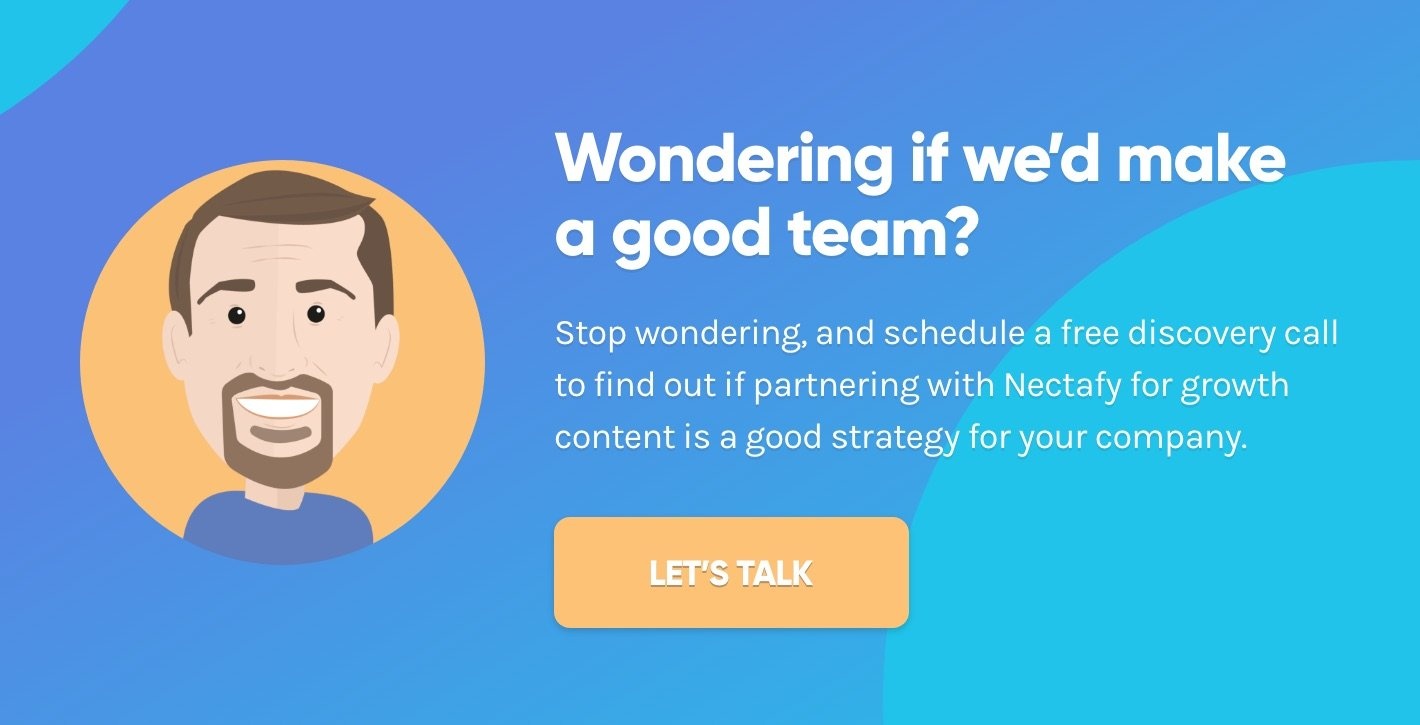Humans vs. AI In Content Marketing: Where will humans outperform AI tools? [Blog + Video]


![Humans vs. AI In Content Marketing: Where will humans outperform AI tools? [Blog + Video]](https://www.nectafy.com/hs-fs/hubfs/Images/Blog/humans-vs-ai-in-content-marketing-where-will-humans-outperform-ai-tools-blog-header.webp?width=900&height=553&name=humans-vs-ai-in-content-marketing-where-will-humans-outperform-ai-tools-blog-header.webp)
When I asked AI to characterize the sentiment of the headlines around AI and its role in content marketing, it gave me this very optimistic response:
“The sentiment around AI's role in content writing, with regard to human involvement, is generally seen as a complementary and augmentative tool rather than a replacement for human creativity and expertise.”
Some content marketers, however, might reply more succinctly, with something like “doom and gloom.” (Particularly if you’ve recently been ousted from your position and had to turn to dog walking or plumbing.)
Perhaps AI is being modest. (Can it even do that?) But we don’t think that’s the case here. No, in this case, we think it’s just flat-out wrong—which isn’t anything new, either.
As much as we might like to believe AI’s take on the matter—that it will simply “augment” and “complement” human work—the reality will probably be different. Content marketers are already well aware of the multitudes of ways in which their work is changing beyond simply having gained a complementary tool. But those changes aren’t ALL bad; in fact, it’s turning out to be quite a mixed bag.
So what’s changing, and where will humans continue to dominate? To get our take on it, you can watch Lance and Emily’s full discussion on the topic, or keep reading for expanded coverage on one of the key areas where we see the biggest change happening at a rapid pace.
Video highlights:
If you’d like to skip to some of the highlights of our latest video discussion on the human’s role in content marketing, the below will serve as a guide:
—How AI can compel us to be better [3:36]
—The importance of life experience in content marketing [6:14]
—TOF/MOF/BOF content discussion [11:52]
—Human understanding of buyer personas [21:28]
—The importance of human-written case studies [24:46]
—The importance of human experts for fact-checking [26:47]
—Using AI as a debate candidate [28:37]
Is your team spinning out trying to keep up with all the changes in marketing? Let’s talk—human to human—and refocus your energies on the activities that produce results.
First… Where AI Excels
One of the things most everyone is taking note of right now is how well AI is assimilating into the barrage of internet content available. That isn’t to say that AI writing is GOOD. On the contrary, in many ways it’s simply a commentary on the sameness of internet content.
AI is trained on virtually all of the text available on the internet (and more), so it makes sense that it can write capably. There’s certainly no shortage of AI “test” videos circulating to see if readers can identify AI vs. human writing. And many times, they can’t.
 Fun fact: Two-thirds of
Fun fact: Two-thirds of
people who think they
would recognize a
chatbot struggle with
identifying AI-generated
texts.
The problem is that too many CEOs are impressed with the fact that AI is able to sound the same as everyone else. Admittedly, the financial aspect of that certainly sounds appealing—why use writers when you can get AI to write for free?
For marketers, however, there’s a bigger question: How is that kind of content helpful to your company?
Since when is “We want to sound the same as our competitors” a valid marketing strategy?
Historically, the way we’ve all survived is by trying to be like other people. We try to say and do the right things to fit in.
But if your content is indistinguishable from that of your competitors, it isn’t doing its job. Generic, AI-written content that sounds like every other article on the same topic loses its impact, and will not move the needle in terms of reader engagement with your brand. That’s because AI content (so far) cannot:
- Write innovative content that springs from the conversations you’re having with colleagues and customers
- Use real stories based on personal experience to answer questions
- Connect with readers’ emotions
- Produce content that relates to your readers’ everyday lives
What AI can do brilliantly is write articles that reflect what everyone else has already said on the topic. This ability to gather information, summarize it, and present it capably isn’t something to be discounted. In fact, AI can still be helpful for producing some types of content—top-of-funnel content specifically.
Where can humans excel in content marketing?
The purpose of TOF content is to raise awareness about topics related to your product or service, usually by answering common questions about those topics. Very often this involves how-to posts, collections of facts, or guides. We believe AI could be a very useful tool for generating these kinds of articles.
See what you think of these two writing samples for a top-of-funnel blog post “guide to website copywriting”:
AI-generated sample |
Human-written sample |
|
From crafting captivating print ads in the early 1900s to captivating radio listeners in the 1940s, copywriting has come a long way. Today, in the digital age, it's all about engaging audiences through websites, social media, and emails. The best practices of copywriting have evolved over time, adapting to changing technologies and consumer preferences. From the limited space constraints of newspapers and magazines to the challenge of crafting compelling radio scripts, copywriters have always been masters of capturing attention. But now, with the endless possibilities of the digital realm, copywriters have become storytellers, building connections with audiences like never before. Join us as we explore the intriguing evolution of website copywriting and reveal how it has transformed into a powerful force in the world of modern marketing. Are you ready to dive into the fascinating world of captivating copy? Let's get started! |
In 1477, some enterprising person created a leaflet to persuade people to buy a new prayer book. Although the thousands-year-old flier itself has disintegrated over time, the act proved to be enduring: here was the birth of copywriting. (Or so the story goes.) We’ve come a long way since then but the fundamentals of copywriting remain the same: the idea is to use words to attract, engage, and persuade. Whether it’s written on papyrus leaf or on the web, best practices are foundational to effective copywriting. Now, writing effective copy for online audiences requires a somewhat different set of rules than those that were used decades ago. Let’s delve into some of today’s website copywriting best practices to learn how to create compelling content that resonates with your audience. |
Although there are differences in the approach and phrasing, both intros provide a solid introduction to a very general topic: website copywriting. This is content meant to give a general overview of the topic to readers, and while you might have a preference as to writing style between the two intros above, you don’t have any indication that the content presented will be different (or lacking) in any substantial way.
Generally speaking, AI does an amazing job of summarizing things, probably even more succinctly than humans could, because again, it's combining the best that it can find around the web. So with AI’s help, you could publish a solid article that answers common questions thoroughly. This is a fine approach for most top-of-funnel content, where the goal is to provide solid information about a wide variety of topics both immediately relevant to and peripheral to your industry that is valuable and useful.
 Fun fact: 66% of bloggers
Fun fact: 66% of bloggers
who use AI primarily create how-to content!
But top-of-funnel content only skims the surface of content marketing. Where we believe humans will do better than AI is in producing middle-of-funnel (MOF) and bottom-of-funnel (BOF) content.
How much could your company grow with growth content?
Calculate your expected growth in organic visits based on the average Nectafy client.
Get all these numbers in your inbox.
Why are humans better at producing MOF and BOF content?
As content marketers, we’re constantly asking: How can we create something useful? How do we create something that connects, that helps people build a relationship with our client in hopes of doing business with them? Middle-of-funnel and bottom-of-funnel content is where that relationship really starts to take form.
People consuming MOF and BOF content have traveled further into the buyer journey and are actively considering the options available to solve their problem—your company included. These types of content only work if they make a human connection. Sure, AI can be “taught” to say things about your company; it can then inject those words into blog posts. But AI cannot speak authentically about customer problems and your company’s solutions, at least, not yet.
For example, people tend to love “comparison” posts—for example, posts that name “the 10 best software products for xx” and highlight each product’s strengths and weaknesses. For the last decade or so, it’s been very easy for someone to produce this type of article. An author can simply rehash the pros and cons as they appear on all the review sites—but has probably never personally used the product in their life.
Below are two samples of text about the HubSpot CRM dashboard, one generated by AI and one written by a person:
AI-generated comparison text |
Human-written product description sample |
|
The dashboard has been praised for its simplicity, ease of use, and customization options. Users appreciate the intuitive layout of the dashboard, which allows them to easily access and manage their sales, marketing, and customer service activities in one centralized location. HubSpot's CRM dashboard provides a comprehensive overview of key metrics and performance indicators, allowing users to track their sales pipeline, monitor lead generation and conversion rates, and analyze the effectiveness of their marketing campaigns. The platform also offers customizable dashboards, giving users the flexibility to prioritize and display the data that is most relevant to their business goals and objectives. Furthermore, the CRM dashboard integrates with other HubSpot tools and features, such as email marketing, contact management, and task automation, providing users with a seamless and efficient workflow. Overall, while specific reviews of HubSpot's CRM dashboard may vary, the platform generally receives positive feedback for its user-friendly interface, informative data visualization, and ability to help businesses effectively manage their sales and marketing activities. |
Here’s a breakdown of the productivity section of the CRM dashboard:
|
How do you feel about the AI-generated text vs. the human-written text above? Did one feel more authentic than the other? I suspect I know the answer. 🧐
People want to hear first-hand stories, observations, and insights, not content that’s been spun up based on previous content. Companies that truly want to drive engagement will need to rely on in-house experts and content writers to help produce it. Authentic experiences and information will ultimately rise to the top because they are more valuable—even if that means a single blog post takes three months of work instead of 10 minutes.
The best bottom-of-funnel content can only come from people—the CEOs, CFOs, passionate individual contributors, engineers, etc. who have real opinions about their product or service and are willing to convey their insights and passion via content, whether that’s a video, a blog post, a downloadable asset, or anything else. Companies that master the skill of being able to convey how their product or service really MATTERS to people are the ones who are going to succeed with content marketing.
That kind of authenticity matters so much more at the middle and bottom of the sales funnel than at the top. When humans truly connect with humans—that’s the stuff conversions are made of. That’s where it pays to lean into your company’s individuality.
Talk to us about how we can work together to produce the kind of MOF and BOF content that drives conversions! (Lance loves to talk…)
Here at Nectafy, we’re still navigating this new AI landscape, trying to figure out how best to use it to “complement” human work yet still retain that human connection that drives sales. If you have any comments or insights you’d like to share with regard to AI and content marketing, we’d love to hear about them in the comments below.

